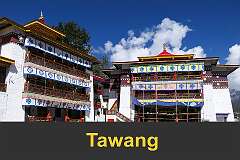
- Assam
- Delhi
- Goa
- Himachal Pradesh
- Jammu & Kashmir
- Kerala
- Ladakh
- Madhya Pradesh
- Meghalaya
- Mizoram
- Nagaland
- Punjab
- Rajasthan
- Sikkim
- Tamil Nadu
- Telangana
- Tripura
- Uttar Pradesh
- West Bengal
Arunachal Pradesh, Land of the Dawn-Lit Mountains
23 October - 15 November 2023
Arunachal Pradesh, India’s northeastern frontier state, has a layered history rooted in tribal traditions and geopolitics. For centuries, the region was inhabited by tribes such as the Adi, Apatani, Nyishi, Monpa, and Mishmi, who practised distinct animist and Buddhist faiths while maintaining trade and cultural ties with Tibet and Assam. Monasteries like Tawang reflected Tibetan Buddhist influence, while central tribes upheld the Donyi-Polo faith.
Colonial interest grew in the 19th century, and in 1914, the McMahon Line was drawn at the Simla Convention between British India and Tibet, placing the area within India’s sphere of influence. China, however, rejected the agreement, claiming Tibet lacked the authority to cede territory. After India’s independence, the region became the North-East Frontier Agency (NEFA). During the 1962 Sino-Indian War, Chinese troops briefly occupied parts of NEFA before withdrawing, but China has since continued to dispute the territory, referring to it as “South Tibet.”
In 1972, NEFA was renamed Arunachal Pradesh (meaning “Land of the Dawn-Lit Mountains” in Sanskrit) and granted union territory status, becoming a full-fledged state in 1987. Despite Chinese claims, India administers Arunachal Pradesh, a culturally diverse region comprising over 20 major tribes, renowned for its rich heritage, natural beauty, and strategic importance.
Colonial interest grew in the 19th century, and in 1914, the McMahon Line was drawn at the Simla Convention between British India and Tibet, placing the area within India’s sphere of influence. China, however, rejected the agreement, claiming Tibet lacked the authority to cede territory. After India’s independence, the region became the North-East Frontier Agency (NEFA). During the 1962 Sino-Indian War, Chinese troops briefly occupied parts of NEFA before withdrawing, but China has since continued to dispute the territory, referring to it as “South Tibet.”
In 1972, NEFA was renamed Arunachal Pradesh (meaning “Land of the Dawn-Lit Mountains” in Sanskrit) and granted union territory status, becoming a full-fledged state in 1987. Despite Chinese claims, India administers Arunachal Pradesh, a culturally diverse region comprising over 20 major tribes, renowned for its rich heritage, natural beauty, and strategic importance.


















